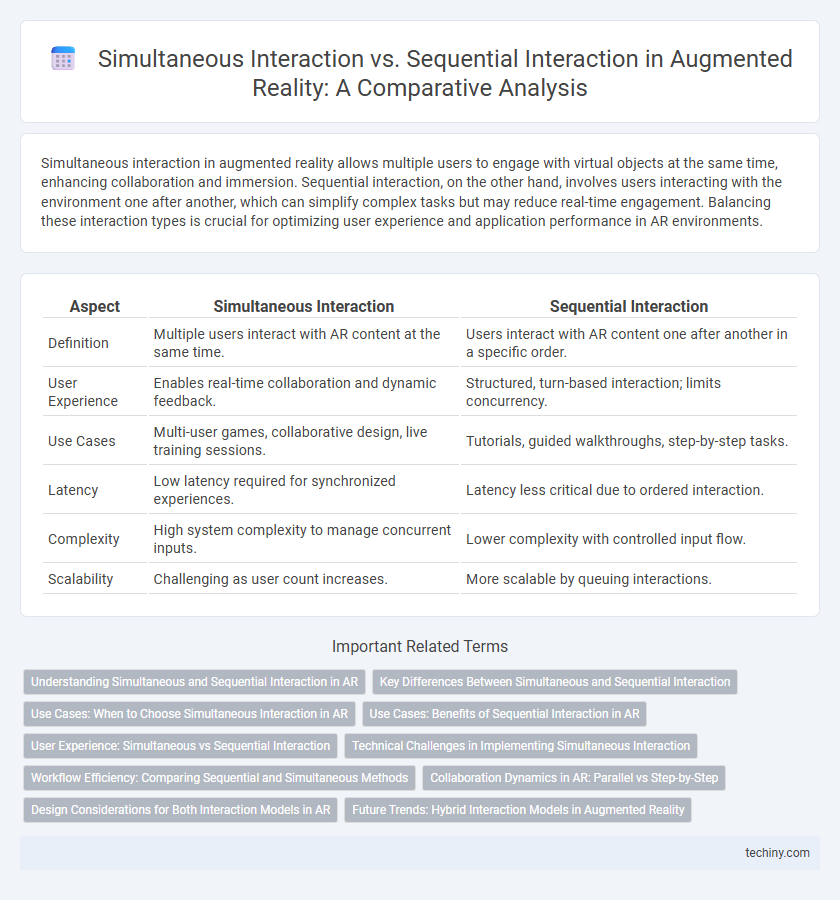Simultaneous interaction in augmented reality allows multiple users to engage with virtual objects at the same time, enhancing collaboration and immersion. Sequential interaction, on the other hand, involves users interacting with the environment one after another, which can simplify complex tasks but may reduce real-time engagement. Balancing these interaction types is crucial for optimizing user experience and application performance in AR environments.
Table of Comparison
| Aspect | Simultaneous Interaction | Sequential Interaction |
|---|---|---|
| Definition | Multiple users interact with AR content at the same time. | Users interact with AR content one after another in a specific order. |
| User Experience | Enables real-time collaboration and dynamic feedback. | Structured, turn-based interaction; limits concurrency. |
| Use Cases | Multi-user games, collaborative design, live training sessions. | Tutorials, guided walkthroughs, step-by-step tasks. |
| Latency | Low latency required for synchronized experiences. | Latency less critical due to ordered interaction. |
| Complexity | High system complexity to manage concurrent inputs. | Lower complexity with controlled input flow. |
| Scalability | Challenging as user count increases. | More scalable by queuing interactions. |
Understanding Simultaneous and Sequential Interaction in AR
Simultaneous interaction in augmented reality (AR) allows multiple users to engage with digital content at the same time, enhancing collaborative experiences and real-time feedback. Sequential interaction involves users interacting with AR elements one after another, which can be effective for guided tutorials or step-by-step instructions. Understanding these interaction modes in AR is crucial for designing intuitive user experiences that align with specific application goals and user needs.
Key Differences Between Simultaneous and Sequential Interaction
Simultaneous interaction in augmented reality allows multiple users or devices to engage with virtual content at the same time, enabling collaborative experiences and real-time feedback. Sequential interaction involves users engaging with the AR environment one after another, often resulting in a linear progression of tasks or information processing. Key differences include timing and user engagement patterns, where simultaneous interaction fosters dynamic teamwork, while sequential interaction supports step-by-step exploration or instruction.
Use Cases: When to Choose Simultaneous Interaction in AR
Simultaneous interaction in augmented reality is ideal for collaborative environments where multiple users must engage with digital content at the same time, such as in industrial design reviews or medical training simulations. This interaction type enhances real-time teamwork and decision-making by allowing participants to manipulate and analyze 3D models concurrently. Choosing simultaneous interaction enables seamless coordination and accelerates workflow efficiency in complex, time-sensitive AR use cases.
Use Cases: Benefits of Sequential Interaction in AR
Sequential interaction in augmented reality (AR) prioritizes step-by-step user engagement, enhancing clarity and focus in complex tasks such as industrial training and medical procedures. This approach reduces cognitive overload by guiding users through ordered instructions, improving task accuracy and learning efficiency. Use cases like surgical navigation and equipment assembly benefit from sequential interaction by minimizing errors and increasing overall operational safety.
User Experience: Simultaneous vs Sequential Interaction
Simultaneous interaction in augmented reality enhances user experience by allowing multiple inputs or gestures to be processed at once, creating a more natural and immersive environment. Sequential interaction, on the other hand, processes inputs one at a time, which can reduce cognitive load but may slow down task completion and limit the feeling of presence. Optimizing user experience in AR depends on balancing these interaction modes to suit specific applications, ensuring responsiveness and intuitive control.
Technical Challenges in Implementing Simultaneous Interaction
Simultaneous interaction in augmented reality demands advanced gesture recognition algorithms and low-latency sensor fusion to accurately track multiple users or hands concurrently. Hardware limitations like processing power and sensor resolution pose significant challenges in ensuring real-time responsiveness and reducing input lag. Achieving seamless simultaneous interaction also requires robust conflict resolution mechanisms to handle overlapping inputs and maintain user experience consistency.
Workflow Efficiency: Comparing Sequential and Simultaneous Methods
Simultaneous interaction in augmented reality enables multiple users to engage with the same digital elements concurrently, significantly enhancing workflow efficiency by reducing wait times and promoting real-time collaboration. Sequential interaction, in contrast, requires users to interact one after another, which can create bottlenecks and slower task completion in complex projects. Research shows that simultaneous methods improve task throughput by up to 40% compared to sequential workflows in AR environments.
Collaboration Dynamics in AR: Parallel vs Step-by-Step
Simultaneous interaction in augmented reality enables multiple users to engage collaboratively in real time, enhancing parallel task execution and fostering immediate feedback loops. Sequential interaction, by contrast, structures collaboration in a step-by-step manner, allowing users to focus on discrete tasks one after another, which can improve accuracy and reduce cognitive overload. Understanding the balance between these interaction modes is crucial for designing effective AR collaborative environments that optimize teamwork efficiency and user experience.
Design Considerations for Both Interaction Models in AR
Designing for simultaneous interaction in augmented reality requires optimizing spatial awareness and real-time data processing to prevent user input conflicts and maintain fluid engagement. Sequential interaction models emphasize clear transition cues and temporal sequencing to guide users through tasks without cognitive overload. Both approaches demand adaptive interface elements that respond dynamically to user behavior and environmental context for enhanced usability.
Future Trends: Hybrid Interaction Models in Augmented Reality
Future trends in augmented reality emphasize hybrid interaction models that seamlessly integrate simultaneous and sequential interactions to enhance user experience. These models leverage real-time data processing and adaptive user interfaces to allow multitasking and contextual transitions between interaction modes. Advances in AI-driven gesture recognition and predictive analytics play a crucial role in optimizing hybrid interaction frameworks for immersive AR applications.
Simultaneous interaction vs Sequential interaction Infographic

 techiny.com
techiny.com